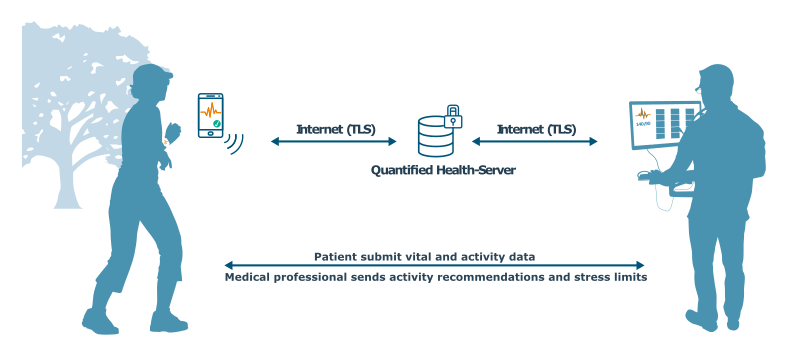Should I exercise? Is a bike ride overdoing it? These are some of the questions commonly asked by patients with heart problems, tumors or orthopedic problems. In the future, the “Quantified Health System” from the Fraunhofer Institute for Open Communication Systems FOKUS might be able to help individuals with questions like these: The system uses a fitness wristband that detects vital signs such as pulse, processes this data statistically and sends it to the patient’s doctor, who then sets individual health goals based on this information.
If the heart is not pumping enough oxygen around the body, people often get worried about putting too much stress on their body. Patients with other heart conditions and those who have/have had cancer or suffer from orthopedic problems also tend to take it easy. Going for walks or riding a bike? Better not do that! However, being active – without overdoing it – is a key part of the recovery process. Having said this, for most patients, the question “How much should I take on?” is not so easy to answer, particularly when they are more or less on their own following their hospital stay and rehabilitation.

© Fraunhofer FOKUS
A special app provides patients with an overview of their health data and transmits this over a server to their doctor, who can send them activity recommendations in return.
Always playing it safe
In the future, the “Quantified Health System” from Fraunhofer FOKUS will be able to help patients find the right balance between looking after themselves and keeping active. “The Quantified Health System gives both patients and medical staff a continuous insight into the patient’s vital signs and current health condition,” explains Anne Grohnert, Head of the Telehealth Technologies research group at Fraunhofer FOKUS. The principle here is that the patient wears an off-the-shelf fitness wristband or smartwatch that detects vital signs and sends the corresponding data to a special smartphone app. Patients can use this app to monitor their own data: They can view their current step count and pulse rate as well as record their weight and blood pressure. On the app, they have constant access to the training plan that was agreed with their doctor and/or therapist, giving them an overview of their fitness goals. The app also has a diary function that patients can use to make notes on their current condition, such as if they feel unwell. Furthermore, the app sends the data to a server multiple times a day, where it is statistically processed and forwarded to the patient’s doctor. The doctor can then display the data in various ways, such as changes to the pulse over time, on a suitable user interface on their computer. Are there any outliers? Was the patient moving around when their pulse rate went up, or were they lying calmly on the couch? The doctor can send suitable activity recommendations and goals based on this data, which the patient can access via the app. For example, “Please walk 7,000 steps per day.” If required, the doctor and patient can also communicate with each other over video call via the app and user interface.
As part of this project, the research prototype was initially adapted to three different indications from the fields of cardiology, oncology and orthopedics. It is currently in testing as part of a feasibility study at three medical research institutions. “Among other things, we are investigating the extent to which the requirements for these types of systems differ for different indications. As a result, we are also keeping an eye on user behavior,” explains Grohnert. Researchers are working with Theraphysia GmbH on orthopedics; with the Kardiologische Gemeinschaftspraxis am Park Sanssouci on cardiology; and with the Reha-Zentrum Lübben GmbH on oncology. They are also trying to answer another key research question: How can different off-the-shelf wearables – from low price models that cost 25 euros to smart watches for 400 euros – be integrated into the system? Is the quality of data from these standard components sufficient to be used in the medical domain?
Feasibility study: trial involving approximately 60 patients
A feasibility study should help to answer these questions. Approximately 60 patients from the three partner research institutions are participating for three months. The data will be evaluated in October and November 2022. However, Grohnert can say this much already: “We have got a good idea of what the doctors, therapists and patients think: For the most part, they think that the system is good, useful, helpful and motivating. Its also scores highly in terms of usability. In short, the patients have embraced it – ultimately, they are still in direct contact with their therapists to an extent that would otherwise not be possible,” says Grohnert.
The researchers will present the new system at the MEDICA trade show in Dusseldorf from November 14 to 17 (Hall 3/Booth E74).
Source: Fraunhofer Institute for Open Communication Systems FOKUS (fokus.fraunhofer.de)